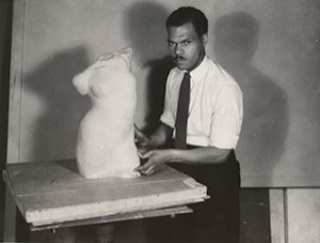Born 1910, Wetumka, Oklahoma
Died 1965, Ellsworth, Maine
Henry Bannarn moved with his family from Oklahoma to Minnesota as a child. Through the support of philanthropist James Ford Bell, president of General Mills, as well as the Phyllis Wheatley House in Minneapolis, Bannarn received a scholarship to study at the Minneapolis School of Fine Arts (now the Minneapolis College of Art and Design) before relocating to New York City and attending the Beaux-Arts Institute of Design. Along with painting and sculpting, Bannarn was always committed to teaching. In Minneapolis he taught drawing courses at Wheatley House, and in New York he taught alongside Charles Alston and Augusta Savage at the WPA-sponsored Harlem Art Workshop, located at 306 West 141st Street. Known as “Studio 306” or simply “306,” this center served as the training ground for the next generation of modern African American artists, notably Romare Bearden, Jacob Lawrence, and Norman Lewis.
Bannarn’s sculptures were widely seen not only at 306 in New York but throughout the country as part of the Harmon Foundation’s touring exhibitions. They were praised by James Porter, a Howard University art historian and author of Modern Negro Art, the first survey text dedicated to African American art and material culture. Porter recognized Bannarn as one of the foremost sculptors of the Harlem Renaissance and celebrated how he “unites passion and massive strength” in his sculptural forms. He specifically commented on the artist’s bust of John Brown, which blends technical virtuosity with “animal strength and intellectual beauty.” Indeed, Bannarn’s blocky, stylized, and frontal presentation of the abolitionist martyr—rough-hewn, with its surface marked by highly complex, modulating textures—bears some resemblance to African art, a source of formal and ideological inspiration to many African American artists during the Harlem Renaissance. In Bannarn’s handling, Brown possesses an authoritative and commanding gaze, which highlights his iconic status in radical politics and struggles for black liberation in the US.
Nicholas Miller
Buick, Kirsten Pai. “Between a Rock and a Hard Place: Sculpture of the Harlem Renaissance.” In A Companion to the Harlem Renaissance. Ed. Cherene Sherrard-Johnson, 317–336. Hoboken, NJ: Wiley-Blackwell, 2015.
Porter, James A. Modern Negro Art. New York: Dryden Press, 1943.
